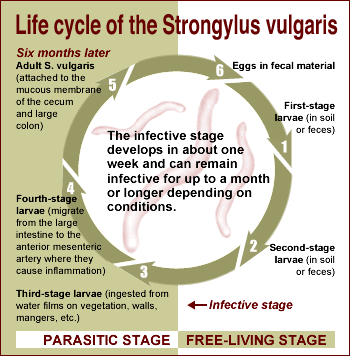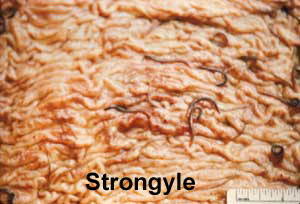Internal parasites are small organisms that live a portion of their life cycle in a host animal. They live in internal organs, body cavities, and tissues while gaining their nutritive source by feeding on the host animal. The horse is affected by many different species of parasites. The nature and extent of damage varies with the parasite.
Parasite infestation causes loss of nutrients or blood from the host, resulting in serious medical problems. Horses heavily burdened with parasites will have a loss of condition due to a depletion of nutrients and blood, decreased growth, and reduced reproductive and athletic performance.
Numerous internal parasites infect horses, but there are only a few that commonly cause significant health problems. To establish an effective parasite control program, it is important to first understand the life cycle of parasites. Successful prevention and control programs are effective because they interrupt the life cycles of parasites. In some areas of the country, the primary class of internal parasites that cause health problems for horses are nematodes, such as large and small strongyles, ascarids, and tapeworms. Other internal parasites perhaps of lesser significance, such as pinworms and botfly larvae, are often considered when designing a parasite control program.
Strongyles
Strongyles are grouped as either large or small. The three primary species of large strongyles that infect the horse are Strongylus vulgaris, Strongylus endentatus, and Strongylus equinus.
The adult form of all strongyles (large or small) live in the large intestine. Adult strongyles produce eggs that are passed out in the feces into the horse’s environment. These eggs then develop into infective larvae that exist on the pasture vegetation or in stalls. The horse is infected when it consumes grass, feed, or water contaminated with infective larvae. These larvae are very resistant to harsh environmental conditions because of a protective sheath. Strongyles can survive in a freezing environment, but a hot and dry environment will often kill them. The infective larvae survive up to 31 weeks at winter temperatures, compared to up to seven weeks at summer temperatures.
The larvae of large strongyles migrate through various parts of the body. Strongylus vulgaris, the bloodworm, will burrow into and migrate in the walls of the arteries that are the primary blood supplier to the small and large intestines. This migration can result in the formation of blood clots, which can disrupt the blood flow to the intestines and cause scar tissue formation in affected arteries. After approximately 120 days, the larvae move to the lumen of the large intestine, where maturation is completed. As adults, these parasites will lay several thousand eggs each day, completing the life cycle. The entire life cycle takes six to seven months.
The other two large strongyles (Strongylus endentatus and Strongylus equinus) have similar life cycles, but their larval migration is primarily through the liver. This migration results in damage to the organ but not nearly to the extent of the S. vulgaris migration through the intestinal blood supply. S. endentatus and S. equinus larvae also return to the large intestines, where they mature into adults. Their life cycle is approximately eight to 11 months.
The use of effective anthelmintic (antiparasitic) compounds has reduced the prevalence of large strongyles which, in the past, have caused the most damage to horses. The small strongyle is considered to be the most common internal parasite of horses. Horses can be infected with small strongyles and show no overt signs of disease. However, severely infected horses may exhibit clinical signs, such as sudden onset of diarrhea and colic. Small strongyles have been implicated in causing decreased feed efficiency, rate of gain, and performance.
The life cycle of the small strongyle (cyathostomes) is very similar to large strongyles except the larvae do not migrate beyond the wall of the intestines. The larvae burrow in or encyst in the wall of the large colon. Horses with heavy infestations will show clinical signs of diarrhea and negative growth performance. These clinical signs usually occur when large numbers of the encysted cyathostomes emerge from the gut wall, resulting in inflammation. The severity of clinical signs is related to the degree of damage to the intestines, which varies with the level of infection. At present, it is unclear why the cyathostomes tend to emerge all at once. It is postulated that the occurrence of larval cyathostomosis may be associated with:
- seasonal factors (winter/spring in northern areas, spring/summer in southern areas)
- antiparasitic treatment within two weeks
- young horses (less than six years).
Craig Wood, University of Kentucky




